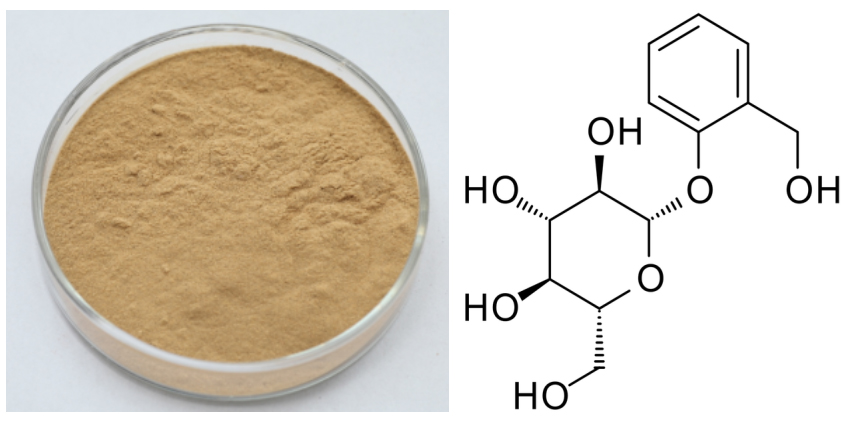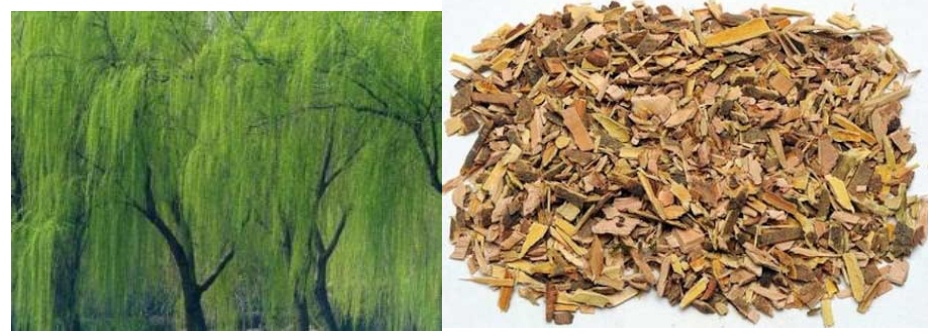Professional Manufacturer for White Willow Bark Extract Factory for Chad
Professional Manufacturer for White Willow Bark Extract Factory for Chad Detail:
[Latin Name] Salix alba L.
[Plant Source] from China
[Specifications] Salicin 15-98%
[Appearance] Yellow Brown to White powder
Plant Part Used: Bark
[Particle size] 80 Mesh
[Loss on drying] ≤5.0%
[Heavy Metal] ≤10PPM
[Storage] Store in cool & dry area, keep away from the direct light and heat.
[Shelf life] 24 Months
[Package] Packed in paper-drums and two plastic-bags inside.
[Net weight] 25kgs/drum
Brief Introduction
Salicin is a naturally occurring compound found in the bark of several species of trees, primarily North American in origin, that are from the willow, poplar, and aspen families. White willow, from whose Latin name, Salix alba, the term salicin is derived, is the most well known source of this compound, but it is found in a number of other trees, shrubs, and herbaceous plants as well being synthesized commercially. It is a member of the glucoside family of chemicals and is used as an analgesic and antipyretic. Salicin is used as a precursor for the synthesis of salicylic acid and acetylsalicylic acid, commonly known as aspirin.
A colorless, crystalline solid in its pure form, salicin has the chemical formula C13H18O7. Part of its chemical structure is equivalent to the sugar glucose, meaning it is classified as a glucoside. It is soluble, but not strongly so, in water and alcolhol. Salicin has a bitter taste and is a natural analgesic and antipyretic, or fever reducer. In large quantities, it can be toxic, and overdoses may lead to liver and kidney damage. In its raw form, it may be mildly irritating to skin, respiratory organs, and eyes.
Function
1. Salicin is used to ease pain and reduce inflammation.
2. Relieve acute and chronic pain, including headache, back and neck pain, muscle aches, and menstrual cramps; Control arthritis discomforts.
3. Relieve acute and chronic pain.
4. It has the same effect on the body as aspirin without any of the side effects.
5. It is an anti-inflammatory, a fever reducer, an analgesic, an anti-rheumatic, and an astringent. Specifically, it helps to relieve headaches.
Application
1.Anti-inflammatory, anti-rheumatic,
2.Reduce a fever,
3.Use as an analgesic and astringent,
4.Relieve headache,
5.Ease pain caused by rheumatism, arthritis, and carpal tunnel syndrome.
Product detail pictures:
Related Product Guide:
It truly is our responsibility to fulfill your requirements and successfully provide you. Your fulfillment is our best reward. We're seeking forward in your check out for joint development for Professional Manufacturer for White Willow Bark Extract Factory for Chad , The product will supply to all over the world, such as: USA, Thailand, Kuwait, We follow up the career and aspiration of our elder generation, and we're eager to open up a new prospect in this field, We insist on "Integrity, Profession, Win-win Cooperation", because we have now a strong backup, that are excellent partners with advanced manufacturing lines, abundant technical strength, standard inspection system and good production capacity.
https://davesmith.ludaxx.com/
https://www.davegsmith.com
Why it Works for
F21 is an All Natural Sugar Blocker that helps limit your blood sugar absorption. It consists of different compounds found to have various health benefits, such as L-Arabinose, Coriolus Versicolor Polysacchride, Konjac-Mannan, Magnesium Stearate, Mint flavor: Menthol and Natural Colors. F21 not only does it help promote weight loss, (PSK) boosts your immune system response. In fact, for every gram of F21, you can block up to 20 grams of sugar (sucrose). The formula not only helps promote weight loss, it benefits the digestive system by allowing the blocked sucrose to support beneficial probiotic bacteria while the polysaccharide (PSK) boosts your immune system response.
But how does this formula break down the sugar in our bodies? There are basically three steps:
STEP 1
Sugar (sucrose) enters the body as a whole molecule.
STEP 2
The enzyme “sucrose” separates the sucrose molecule into two individual sugar molecules, Glucose and Fructose, which then enter the blood stream to be used. F21 inhibits sucrose from separating the sucrose molecule.
STEP 3
Instead of the sugars entering the blood stream, the whole sucrose molecule and F21 remain in the digestive tract and become prebiotics.
The main ingredient in F21 is L-Arabinose, which helps prevent sugar (sucrose) from being metabolized in the body. It also helps to satisfy any cravings for sugar. Another ingredient, Polysaccharide (PSK), is an extremely powerful antioxidant and immune-regulatory defender. It’s well researched anti-tumor, anti-infection and anti-inflammation effects help repair damaged cells and support the immune system.
Konjac-Mannan is a natural appetite suppressant. It acts as a trigger signaling your stomach to feel a little more satisfied and can help to reduce hunger cravings.
Prebiotics are indigestible fibers that are food for the probiotics. Both F21 and the whole sucrose molecule remain in the large intestine and become food for probiotics.
Menthol is an organic compound made synthetically or obtained from cornmint, peppermint or other mint oils. Menthol has local anesthetic and counterirritant qualities, and it is widely used to relieve minor throat irritation. It is known to be a powerfully medicinal compound linked to several potential health benefits. Peppermint oil, a natural source of menthol, has been investigated as a treatment for several diseases and conditions.
Magnesium stearate, also called octadecanoic acid, is manufactured from both animal and vegetable oils and this is the reason why some nutritional supplements specify that the magnesium stearate used is sourced from vegetables.
Please watch: “Morola Macher Jhal Chorchori – Bengali Recipe || How to make Mourola Macher Jhal || মৌরলা মাছের ঝাল”
-~-~~-~~~-~~-~-
Bhindi Fry/ Lady’s finger fry/ bhendi fry is the simple but tasty recipe. It is also good for health.
Ingredient:-
Lady’s Finger – 300 gm
Green Chili – 5 pc
Sliced Onion – 2 pc
Turmeric Powder – 1 tea spoon
Salt – to taste
Oil – as per requirement
Watch other tasty recipe videos on YouTube just one click:
Ilish Polao Recipe Bengali | Hilsha Polao | How to make Ilish Polau | ইলিশ পোলাও
Fish Kalia | Rui macher kalia | Rohu fish recipe | Bengali fish curry | রুই মাছের কালিয়া রেসিপি
Pulao | Polao l How to cook plain rice Polao in Bengali | প্লেইন পোলাও | Plain Polao Recipe
Aloo Kachori Recipe – Potato Masala Stuffed Kachori | Aloo Puri | Alu Puri | আলু পুরি | আলু কচুরি
Fulcopir Roast Bhajohori Manna Style | Cauliflower Roast | Phulkopir Roast | Roasted Cauliflower
Fried Potato Jacket | আলুর খোসা ভাজা রান্না
Aloo Paneer Recipe Bengali | Aloo Paneer Curry/Cottage Cheese & Potato Curry | আলু পনির রান্না
Chicken Wonton Recipe Bengali | Chinese Fried Wontons Recipe | অনথন | Onthon
Dum Aloo Chicken Recipe in Bengali | Potato Curry Chicken | দম আলু চিকেন
Chicken POPCORN in Bengali | Chicken Pakora Bengali | চিকেন পাকুরা
Khoi Bora | Khoi Pakora | খই বড়া / পাকুরা রান্না
How to make Puli Pitha | পুলি পিঠা | Puli Pitha Recipe Bengali | Vapa Pitha
Chitoi Pitha(চিতই পিঠা)||Chitoi Pitha Recipe||How To Make Chitoi Pitha
Malpua Recipe Bengali Style || মালপোয়া রেসিপি
Nimki / Namakpare recipe | Nimki in bengali | নিমকি রেসিপি বাংলাতে
Narkel Naru Recipe | Coconut Laddu | Narkel Naru Recipe in Bengali | নারকেলের নাড়ু
Tat Khirer Naru | Khir Naru | ক্ষীরের নাড়ু
Bengali Muri Ghonto Recipe |Bengali Fish Head Curry Recipe |কাতল মাছের মুড়ি ঘন্ট
Koi Macher Badha Copy | কৈ মাছ বাঁধাকপি | Cabbage with Climbing Fish
Shol Mulo (শোল মুলো) | Shol mach / Walking fish Mulo Diye | Tasty Recipe
Alur Dum Recipe | Alur Dum Bengali Recipe | Alu dum | Bengali Breakfast recipe | আলুর দম রান্না
Chilli Paneer Recipe Bangla || চিলি পনির || How to Make Chilli Paneer
Kachki Mach Lau Patay Recipe Bangla || কাচকি মাছ লাউ পাতায়
Mutton Kosha Recipe in Bangla || খাসীর মাংস রান্না || How to make Mutton Curry at home in Bangla
Luchi Bengali||Phulko Luchi Bengali||Poori Bengali||ফুলকো লুচি||How to make Luchi
Bangali Taki Mach Recipe || Snakehead Curry || টাকি মাছ লাউ ঘণ্ট রান্না
Chili Chicken Recipe Bangla || চিলি চিকেন রান্না
Vegetable Rice Recipe Bangla / ভেজিটেবল রাইস রান্না
Bangali Palong Shaak /Spinach Recipe (পালং শাক রান্না).
Bengali Bhuna Khichuri Recipe | ভুনা খিচুড়ি রান্না | How to Make Bhuna Khichuri Bangla
The sales person is professional and responsible, warm and polite, we had a pleasant conversation and no language barriers on communication.







